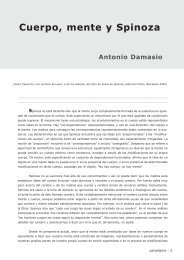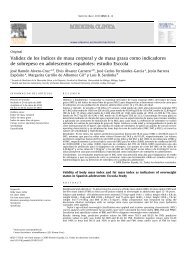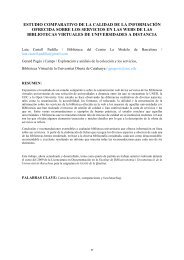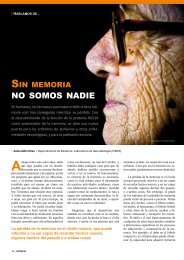Estereotipos negativos hacia la vejez y su relación con variables ...
Estereotipos negativos hacia la vejez y su relación con variables ...
Estereotipos negativos hacia la vejez y su relación con variables ...
You also want an ePaper? Increase the reach of your titles
YUMPU automatically turns print PDFs into web optimized ePapers that Google loves.
Referencias<br />
Tajfel, H. y Turner, J. C. (1986). The social identity theory of intergroup behavior. En S. Wordrel y<br />
W. G. Austin (Eds.). The Psychology of Interroup Re<strong>la</strong>tions. Chicago: Nelson-Hall.<br />
Takahashi, K., Tamura, J. y Tokoro, M. (1997). Patterns of social re<strong>la</strong>tionships and psychological<br />
well-being among the elderly. International Journal of Behavioral Development, 21(3), 417-<br />
430.<br />
Tausch, J. A. (1991). The re<strong>la</strong>tionship between self-<strong>con</strong>cept in elderly and knowledge <strong>con</strong>cerning the<br />
normal aging process. Dissertation Abstracts International, 51(4-A), 1087-1088.<br />
Taylor, S. E. (1981). Cognitive processes in stereotyping and intergroup behavior. Hilldale. NJ:<br />
Erbaum.<br />
Taylor, S. E. y Brown, J. D. (1988). Illusion and Well-Being: A Social Psychological Perspective on<br />
Mental Health. Psychological Bulletin, 103(2), 193-210.<br />
Taylor, S. E., Collins, R. L., Skokan, L. A. y Aspinwall, L. G (1989). Maintaining positive illusions in<br />
the face of negative information: Getting the facts without letting them get to you. Journal of<br />
Social and Clinical Psychology, 8, 114-129.<br />
Taylor, D. A. y Moriarty, B. E. (1987). Inter-group bias as a function of competition and race. Journal<br />
of Conflict Resolution, 31, 192-199.<br />
Terrill, D. (2000). Validity of the life Orientation Test. (optimism). Dissertation abstracts<br />
International . Section B: The Sciences and Engineering, 60(7-B), 3616.<br />
The Valencia Report (2002). A report on outcomes of a meeting of gerontological researches.<br />
Educaters and Providers. Valenciaforum.com/ vfr.html<br />
Theo van Tilburg (1998). Losing and Gaining in old age: Changes in Personal Network Sice and<br />
Social Support in a Four-Year Longitudinal study. Journal of Gerontology, 3b(6), 313-323.<br />
Thimm, A., Rademacher, U. y Fkruse, C. (1998). Age stereotypes and patronizing messages: Features<br />
of age-adapted speech in technical instructions to the elderly. Journal of Applied<br />
Communication Research, 26, 66-82.<br />
Thomae, H. (1983). Altermsstile und Altersschiksale. Ein Beitrac zur Differentielln Gerontologie.<br />
Berna: Huber.<br />
Thomas, E. C. y Yamamoto, K. (1975). Attitudes toward age: An exploration in school-age children.<br />
International Journal of Aging and Human Development, 6, 117- 129.<br />
Thomas, W. C. (1981). The expectation gap and the stereotype of the stereotype. Images of old people.<br />
The Gerontologist, 21, 402-407.<br />
Thompson, E. y Krause, N. (1998). Living alone and neighborhood characteristics as predictors of<br />
social <strong>su</strong>pport in <strong>la</strong>te life. Journals of Gerontology: Series B; Psychological Sciences and<br />
Social Sciences, 53B(6): 354-364.<br />
Thornton, J. E. (2002). Myths of Aging or Ageist Stereotypes. Educational Gerontology, 28(4), 301-<br />
312.<br />
255

















